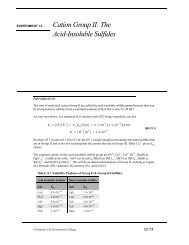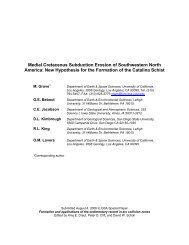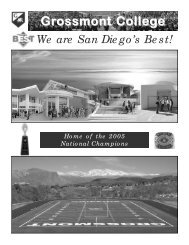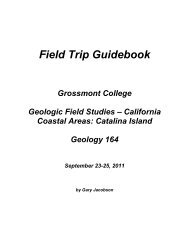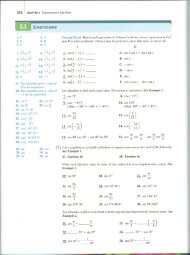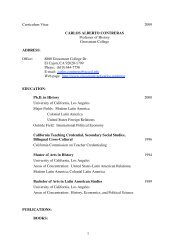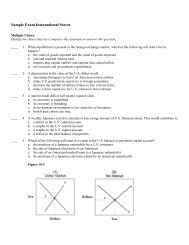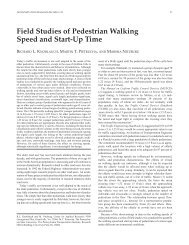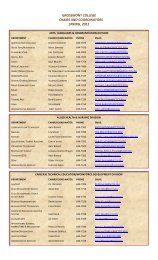Geology of Southern California.pdf - Grossmont College
Geology of Southern California.pdf - Grossmont College
Geology of Southern California.pdf - Grossmont College
Create successful ePaper yourself
Turn your PDF publications into a flip-book with our unique Google optimized e-Paper software.
Ted Soqui/Sygma/Corbis<br />
historic events, these studies underscore the serious seismic<br />
risks that exist in heavily populated southern <strong>California</strong>.<br />
Plate Tectonic Mechanisms: Earthquakes generally result<br />
from the energy released from rocks shattered by the<br />
forces generated along plate boundaries. It is therefore not<br />
surprising that earthquakes are so common in southern<br />
Courtesy NASA/Earth Observatory<br />
� Figure SC.73 A spectacular fire caused by a gas main line<br />
ruptured during the 1994 Northridge earthquake.<br />
<strong>Southern</strong> <strong>California</strong>.9 <strong>Southern</strong> <strong>California</strong> Earthquakes 37<br />
<strong>California</strong>, where the Pacific-North American plate boundary<br />
is so active. However, recall that the San Andreas fault<br />
system is the primary, but not the only, feature involved in<br />
that boundary. A complex network <strong>of</strong> faults crosses <strong>Southern</strong><br />
<strong>California</strong> (Figure SC.74), and several <strong>of</strong> these faults are<br />
more dangerous than the San Andreas as a source <strong>of</strong> future<br />
seismic events. Some <strong>of</strong> the strike-slip faults in this intricate<br />
network are slipping freely several millimeters per year,<br />
releasing stress as it accumulates in the rocks. Such faults pose<br />
little threat <strong>of</strong> a major earthquake. Others, however, appear<br />
to “locked,” storing up energy that may one day be released in<br />
a violent earthquake. The studies <strong>of</strong> ancient earthquakes are<br />
helping to identify which <strong>of</strong> the many strike-slip faults are the<br />
most likely to produce future earthquakes.<br />
In addition to the strike-slip faults produced by shear<br />
forces along the plate boundary, there are many reverse<br />
faults generated by compression in southern <strong>California</strong>.<br />
These reverse faults also are capable <strong>of</strong> producing large<br />
earthquakes. The 1994 Northridge earthquake, for example,<br />
resulted from a rupture along a reverse fault 19 km<br />
beneath the surface. Such deep reverse faults sometimes are<br />
not evident at the surface, because the displacement along<br />
them is largely horizontal and does not always disrupt surface<br />
features. Some geologists refer to these buried faults as<br />
“blind” faults. The presence <strong>of</strong> such unseen faults below the<br />
surface, and their proven potential to generate damaging<br />
earthquakes, adds a discomforting element <strong>of</strong> uncertainty to<br />
the question <strong>of</strong> when and where the next major earthquake<br />
will occur in southern <strong>California</strong>. One way or another,<br />
though, the earthquakes in southern <strong>California</strong>—past, present,<br />
and future–are all related to the forces generated<br />
between the Pacific and North American plates.<br />
Earthquake Forecasts in <strong>Southern</strong> <strong>California</strong>: Even<br />
though scientists have been intensely studying earthquakes<br />
� Figure SC.74 The complex network <strong>of</strong> faults (white lines) capable <strong>of</strong> producing earthquakes in southern <strong>California</strong>.




